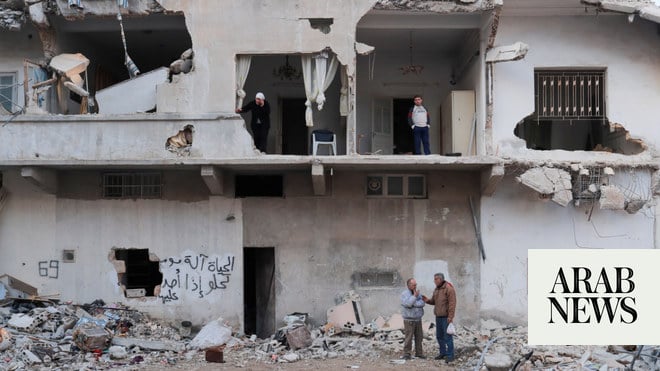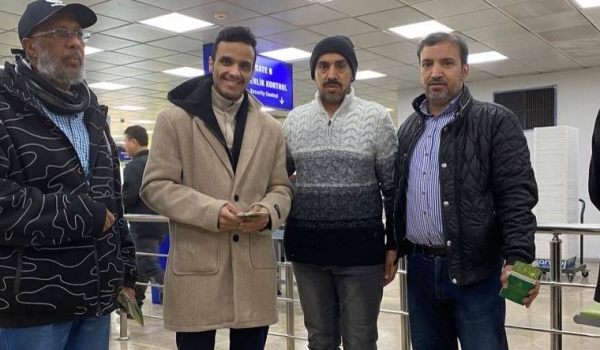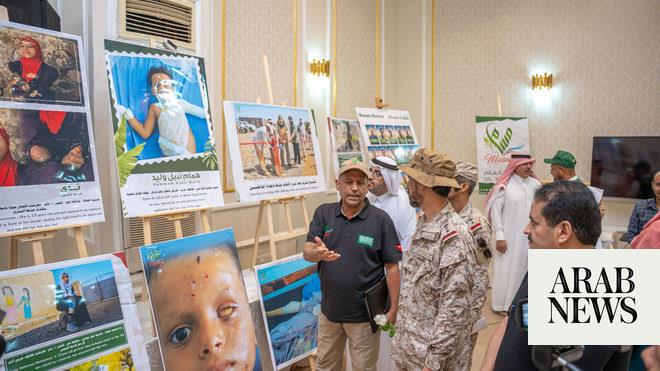
After years of war and displacement in Syria, disaster orphaned many children when their families were lost under rubble
DAMASCUS/ANKARA: No one knows what has become of the two boys whose photos are tied to a tree close to the block of flats where they lived in the earthquake-hit Turkish city of Kahramanmaras.
In one, a baby boy in an orange babygro smiles out from a turquoise armchair, in the other an older boy climbs into a swimming pool, looking proudly into the camera.
“Their parents are deceased,” said earthquake survivor Bayram Nacar, who stood waiting with other local men wearing masks as an excavator cleared a huge pile of shattered concrete and twisted metal rods behind the tree.
He said the bodies of the boys’ parents were still under the rubble. “The father was called Atilla Sariyildiz. His body is yet to be found. We are hoping to find the parents after the excavators remove the debris.”
There are 10 bodies under the rubble, he believes. He does not know if the boys are among them.
The combined death toll in Turkiye and Syria from last week’s earthquake has climbed to more than 41,000, with millions now in need of humanitarian aid after being left homeless in near-freezing winter temperatures.
Drone footage of Kahramanmaras, close to the epicenter of the quake, shows the devastation it caused, leveling buildings and forcing families to seek shelter in tents erected in the city’s stadium.
In the emergency camp, children play between the tents dotted across the field and the running track and a huge line assembles for food.
“We are hoping to go back to our homes. It was a disastrous earthquake and people are in immense pain. Survivors are still scared but despite everything, we stand strong,” said Ali Cevik, a local man now living in a tent.
In another tent, 28-year-old Hatice Kavakdali clutched a grey teddy bear.
“I can’t put the experience we had into words. It was so terrifying and I am still feeling the pain of that,” she said. “I lost consciousness after the quake and I am still recovering. I couldn’t remember my family or how we got out of the house.”
Meanwhile, in a hospital in earthquake-hit northwest Syria, eight-year-old Hanaa keeps asking for news of her family, unaware she is the sole survivor among her immediate relatives.
Her father, mother and four-year-old sister were among the people killed in the quake.
After years of war and displacement in Syria, the disaster orphaned many children when their families were lost under rubble.
“She keeps asking for her father, her mother and her sister,” said Abdullah Sherif, Hanaa’s uncle, at Maarrat Misrine hospital in Syria’s northwestern Idlib province.
“We have not dared to tell her the truth yet.”
Hanaa was trapped for 33 hours under the rubble of her collapsed building in the border town of Harim, before she was pulled out and rushed to the hospital about 25 km away.
When she got there, she was “in a critical condition,” her doctor Bassel Staif said. “She suffered severe dehydration, having been under the rubble without food or water and in the cold weather.”
Hanaa’s condition has since stabilized, and she sometimes smiles despite the injuries on her face.
But her left arm, which is in a cast, was crushed during the quake, Staif said, noting that his team is doing its best to save it.
“She has now left the intensive care unit, her condition is stable. But she is at risk of having an arm amputated.”
In the hospital room packed with Valentine’s Day balloons, Hanaa’s uncle remains by her side. But he fears her condition will only worsen when she learns of her family’s fate.
The little girl has only her grandparents and uncles to raise her in this rebel-held region, home to some 4 million people, many of them displaced from other parts of war-torn Syria.
Last week’s quake has affected more than 7 million children, including 2.5 million in Syria alone, according to James Elder, spokesman for the UN children’s agency UNICEF.
He says the disaster has piled more misery on Syrian children who have only witnessed tragedy in their lives because of the war that broke out more than a decade ago.
Every child under the age of 12 “has known nothing but conflict, violence or displacement,” said Elder. “Some children have been displaced six or seven times.
“For many of these children ... this is trauma on top of trauma.”
Samah Hadid of the Norwegian Refugee Council has also warned that children are at “grave psychological risk due to the scale of the shock.”
Three-year-old Arslan was the sole survivor from his family after their building in Harim was one of least 35 destroyed.
His uncle, Ezzat Hamdi, says rescuers kept digging for three days to find the bodies of Arslan’s father, mother and siblings.
“We found the father’s body hugging the boy,” said Hamdi, 30, adding that the mother’s body was found 2 meters away.
The little boy has since been kept in intensive care, with Hamdi watching over him.
“The child’s lower limbs were crushed” and he suffered internal damage, said doctor Omar Al-Ali of the children’s hospital in Sarmada.
For Obada Zikra, a member of the White Helmets rescue group that operates in Syria’s rebel-held areas, the first hours of the quake disaster were the most agonizing.
“We could only hear the screams and moans of children,” he said, noting the brief bursts of joy whenever rescuers found a child alive. “We have pulled out many children who are still alive, but also dead ones,” he said.










